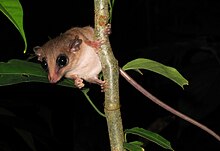Metatheria
| Metatheria Temporal range:
| |
|---|---|

| |
Lycopsis longirostris, an extinct sparassodont, a relative of the marsupials
| |

| |
| A mouse opossum (Marmosa) | |
| Scientific classification | |
| Domain: | Eukaryota |
| Kingdom: | Animalia |
| Phylum: | Chordata |
| Class: | Mammalia |
| Subclass: | Theria |
| Clade: | Metatheria Huxley, 1880 |
| Subgroups | |
| |
Metatheria is a mammalian
Description
Distinctive characteristics (
Evolutionary history
The relationships between the three extant divisions of mammals (monotremes, marsupials, and placentals) was long a matter of debate among taxonomists.[5] Most morphological evidence comparing traits, such as the number and arrangement of teeth and the structure of the reproductive and waste elimination systems, favors a closer evolutionary relationship between marsupials and placental mammals than either has with the monotremes, as does most genetic and molecular evidence.[6]
The earliest possible known metatherian is
Morphological and species diversity of metatherians in
Metatherians arrived in South America from North America during the latest Cretaceous or Paleocene and underwent a major diversificiation, with South American metatherians including both the ancestors of extant marsupials as well as the extinct Sparassodonta, which were major predators in South American ecosystems during most of the Cenozoic, up until their extinction in the Pliocene, as well as the Polydolopimorphia, which likely had a wide range of diets.[10] The oldest known Australian marsupials are from the early Eocene, and are thought to have arrived in the region after having dispersed via Antarctica from South America. The only known Antarctic metatherians are from the Early Eocene La Meseta Formation of the Antarctic Peninsula, where they are the most diverse group of mammals, and include marsupials as well as polydolopimorphians.[10]
Classification
Below is a metatherian cladogram from Wilson et al. (2016):[14]
| Metatheria |
| ||||||||||||
Cladogram after[15]:
| Metatheria | |
Below is a listing of metatherians that do not fall readily into well-defined groups.
Basal Metatheria
- †Archaeonothos henkgodthelpi Beck 2015
- †Esteslestes ensis Novacek et al. 1991
- †Ghamidtherium dimaiensis Sánches-Villagra et al. 2007
- †Kasserinotherium tunisiense Crochet 1989
- †Palangania brandmayri Goin et al. 1998
- †Perrodelphys coquinense Goin et al. 1999
Ameridelphia incertae sedis:
- †Apistodon exiguus (Fox 1971) Davis 2007
- †Cocatherium lefipanum Goin et al. 2006
- †Dakotadens morrowi Eaton 1993
- †Iugomortiferum thoringtoni Cifelli 1990b
- †Marambiotherium glacialis Goin et al. 1999
- †Marmosopsis juradoi Paula Couto 1962 [Marmosopsini Kirsch & Palma 1995]
- †Pascualdelphys fierroensis
- †Progarzonia notostylopense Ameghino 1904
- †Protalphadon Cifelli 1990
Marsupialia incertae sedis:
- †Itaboraidelphys camposi Marshall & de Muizon 1984
- †Mizquedelphys pilpinensis Marshall & de Muizon 1988
- †Numbigilga ernielundeliusi Beck et al. 2008 {Numbigilgidae Beck et al. 2008}
References
- S2CID 206544776.
- hdl:11336/94590.
- ^ S2CID 49183466.
- ^ PMID 25589872.
- ISBN 978-0-8018-8052-0.
- PMID 16291999.
- ^ Rincon, Paul (12 December 2003). "Oldest Marsupial Ancestor Found, BBC, Dec 2003". BBC News. Retrieved 16 March 2010.
- PMID 19419990.
- ^ S2CID 46796692.
- ^ ISSN 0022-2372.
- .
- S2CID 237387495.
- S2CID 249349445.
- PMID 27929063.
- ISSN 1477-2019.




